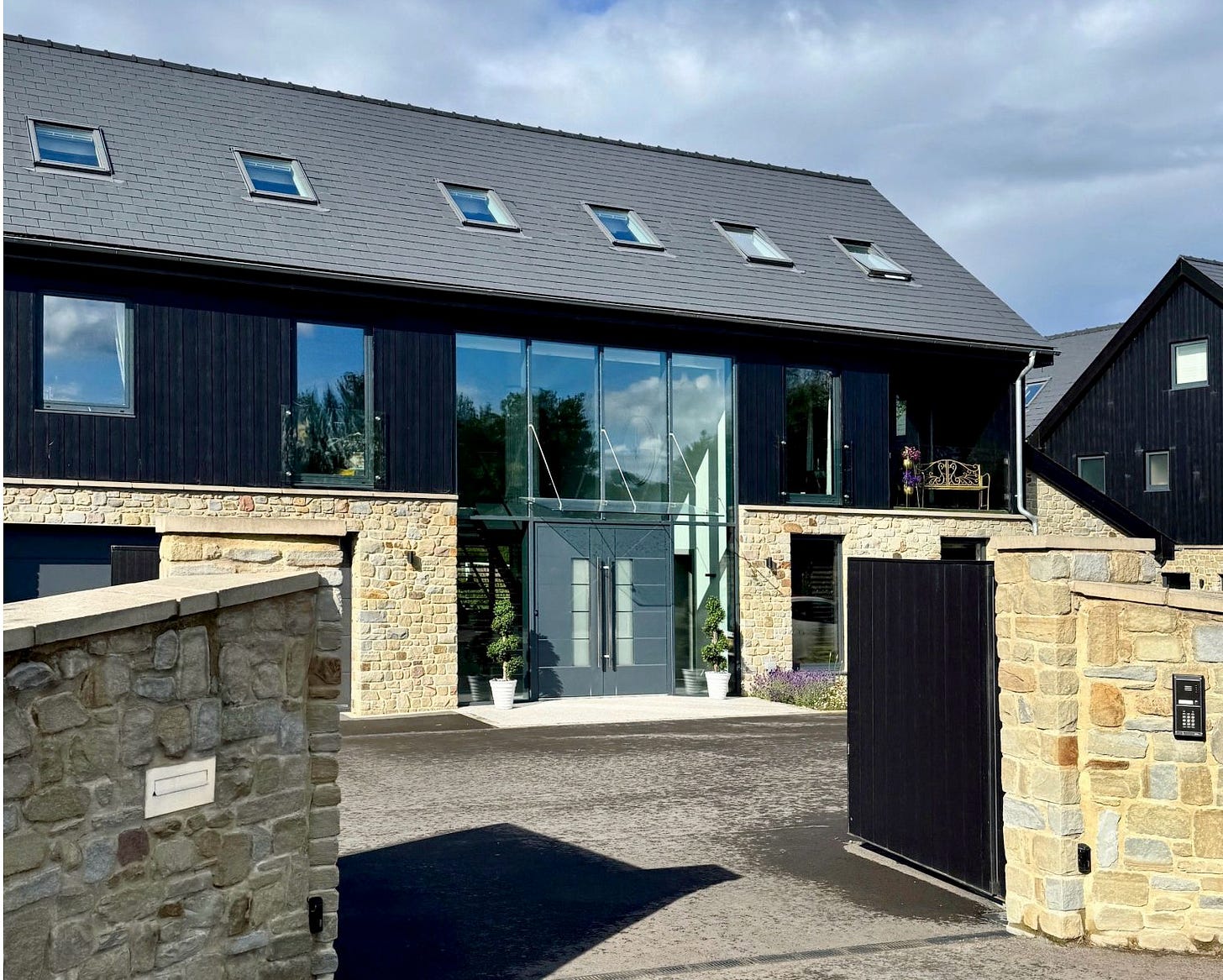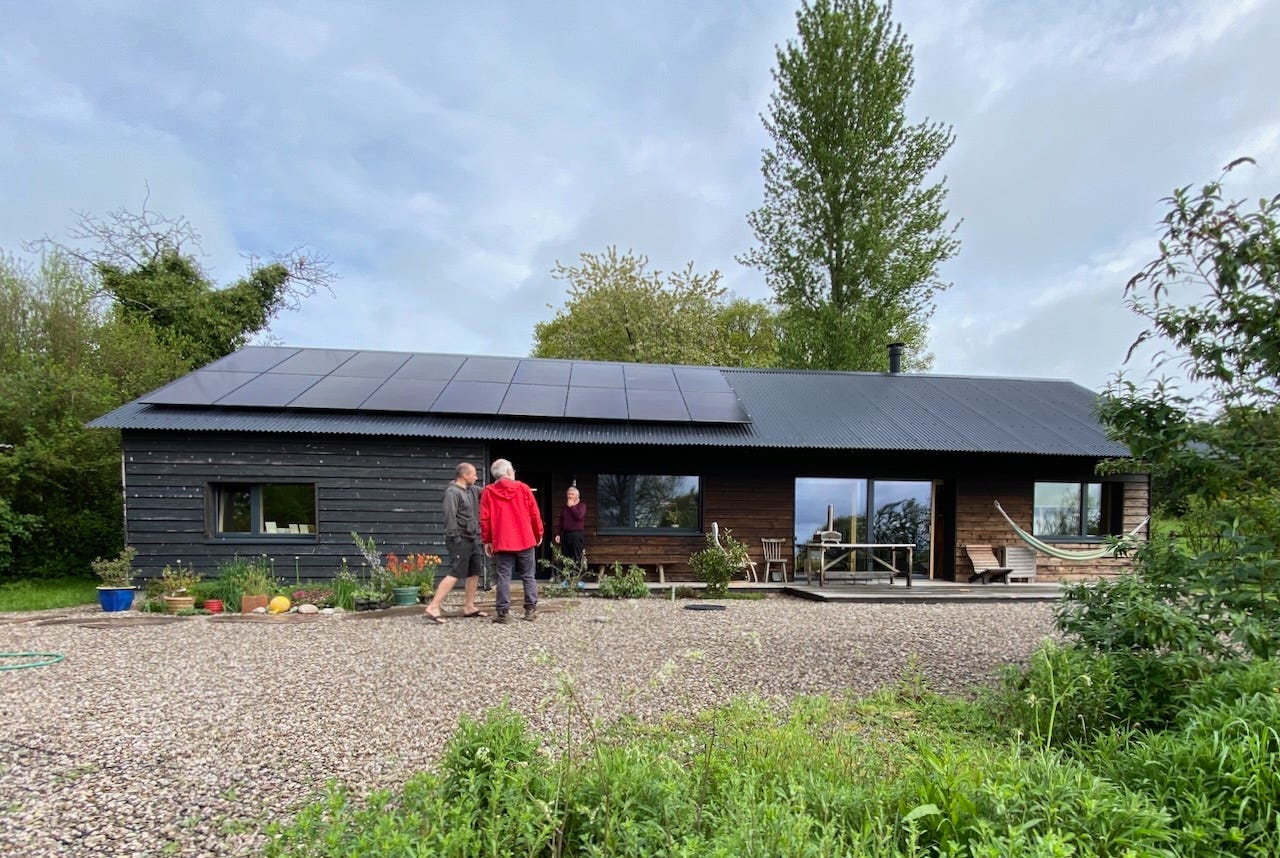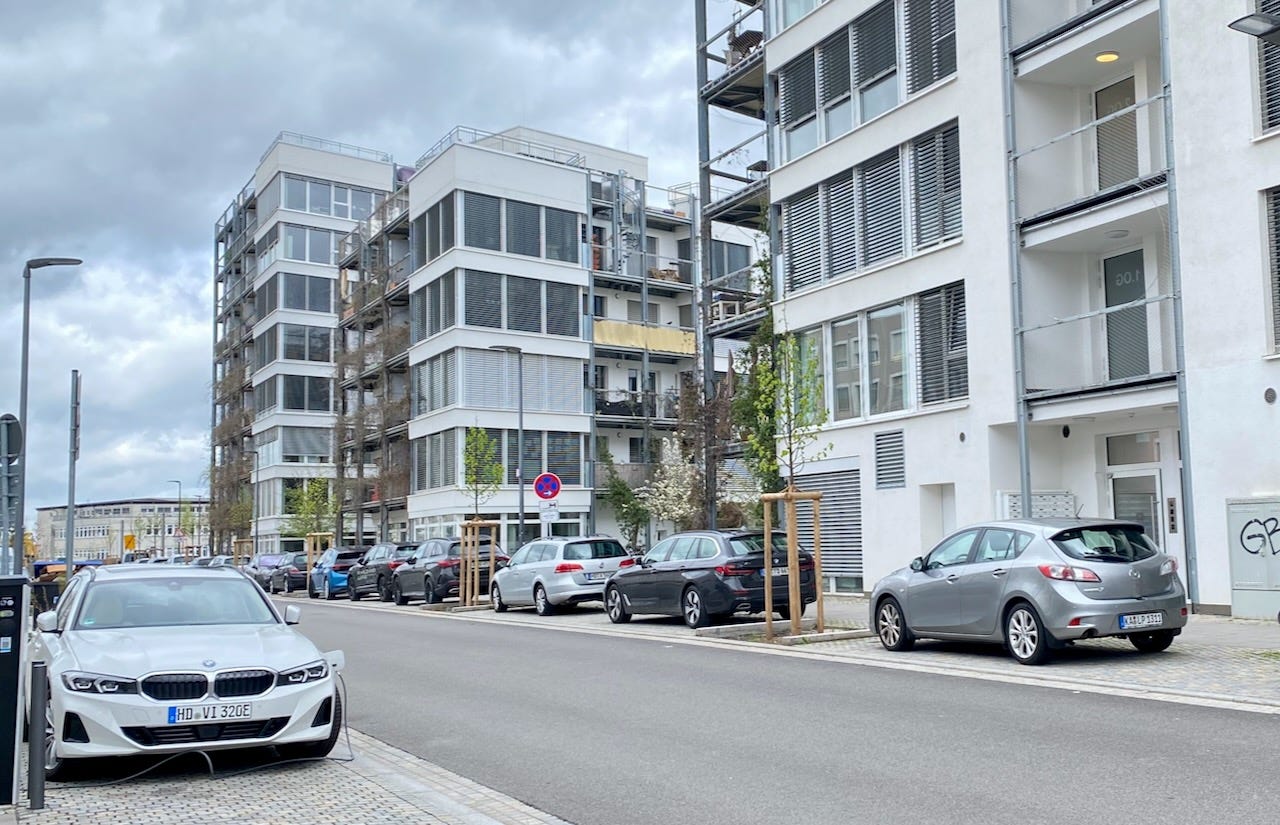What's wrong with this picture?
One architect calls it an "unhappy façade." I think it's worse than that.
Architect George Mikurcik lives in one of the loveliest houses I have ever seen, near Hereford in the UK, and cycles everywhere. He took a photo of this house nearby and noted on Linkedin:
Unhappy facade ☹️
Spotted this overglazed west facing house on my bike ride. Why do people still design houses that are bound to overheat easily?
George’s comment didn’t surprise me at all, given what a problem west-facing windows can be for overheating. What surprised me was the number of people who leapt to its defence with comments like:
“Interesting, how do you know its not designed to pre-heat, glazed areas can be used in vernacular design to drive airflow and pre-heat air in colder periods, the key is where the air goes and when.”
“To some clients, natural lighting is equally important as reducing solar gain and this facade, with an open plan design, permits daylight to penetrate deep into the rear of the house. There is no perfect solution to balance light and heat but combined with MHRV and Low E glass, this facade works well especially in winter months maximising light and solar gain to reduce energy usage.”
Really? At some point, you have to say no, it’s 2024, not 1975. Back then, architects used big windows and thermal mass for passive solar heating, but it never worked very well. Martin Holladay wrote in Green Building Advisor:
While large expanses of south-facing glass help heat up a home on a sunny day, the solar heat gain doesn’t come when heat is needed. Most of the time, a passive solar home has either too much or too little solar heat gain, so much of the solar heat gain is wasted. At night and on cloudy days, large expanses of south-facing glass lose significantly more heat than an insulated wall.
Building science expert Joe Lstiburek says it is the wrong approach:
We were here in the late 1970s when ‘mass and glass’ took on ‘superinsulated.’ Superinsulated won. And superinsulated won with lousy windows compared to what we have today. What are you folks thinking? Today’s ‘ultra-efficient’ crushes the old ‘superinsulated,’ and you want to collect solar energy? Leave that to the PV.”
And they are talking about carefully designed systems with south-facing windows. West-facing windows are almost unmanageable; the sun is too low to permit shading that would keep the sun out in the summer but admit it in the winter.
George’s own house has a lot of glass, but it faces south and is under a deep overhang to keep the summer sun out. He doesn’t have a two-storey high lawyer foyer or a row of skylights that are also thermal nightmares.
George went by the house again and found that the interior blinds were drawn. But they won’t do much; the heat is already inside. How will they survive? With massive amounts of air conditioning. As Reyner Banham wrote in 1968:
“By providing almost total control of the atmospheric variables of temperature, humidity and purity, it has demolished almost all of the environmental constraints on design that have survived that other great breakthrough, electric lighting. For anyone who is prepared to foot the consequent bill for power consumed, it is now possible to live in almost any type or form of house one likes to name in any region of the world that takes the fancy. Given this convenient climactic package one may live under low ceilings in the humid tropics, behind thin walls in the arctic and under uninsulated roofs in the desert.”
What we are seeing here is a house as Banham describes, where environmental constraints have been demolished.
Even the most diehard hippies from the 70s will now admit that air conditioning is becoming a necessity; Alex Wilson of BuildingGreen wrote that In the age of climate change, passive cooling won’t be enough.
I’m increasingly feeling that passive cooling won’t be enough as climate change advances and cooling loads increase. I’m now recommending that in most locations, even if passive conditioning is to be relied on initially, buildings be designed so that they can accommodate mechanical cooling measures down the road.
But you have to do the passive stuff first to minimize it. And that means exterior shading as they do in much of continental Europe; as Mike Eliason explains, “In Germany, virtually every project I worked on (and every place I lived) had active solar protection—operable external shading devices to eliminate solar gains and keep places cooler in summer and shoulder seasons.”
And size your windows for their function, not for how much you like the look of a glazed two-storey lobby. As the late Monte Paulsen noted,
“Over-glazing brings high heat loss, overheating, storm damage, and costs more. Only place a window where it has a specific purpose and where it is the best solution to serve that purpose. Common purposes: light, view, ventilation.”
Some of the commenters on Linkedin and no doubt some of my commenters will say things like, “What’s it to you? If it meets the building codes and they have the money to pay for the air conditioning and heating, who are you to complain?” The problem is that this kind of design creates peak load demand on the hottest days in summer and the coldest nights in winter. Everybody pays to build and run an electrical system that can cope with that; it affects all of his neighbours. If we are going to have a chance of electrifying everything and running on renewables, we have to reduce demand and shave the peaks.
We also have to change the codes to make Passivhaus the minimum standard and put limits on embodied or upfront carbon per square meter. If people have the money to build a house like this, they can afford to make it efficient and low-carbon.
George described this house as having an “unhappy façade.” I think stronger adjectives are needed, and I hope that someday it will be considered an “illegal façade” under stronger codes.
What adjectives would you use?
I have written a lot about windows here and on Green Building Advisor and am in the middle of a chapter on them for my new book. Here is some more reading:
Why we need “windows with purpose” As the world heats up, we have to rethink how we design them, especially in multi-family dwellings.
The new manual: What is the purpose of a window? Do we need them at all? If so, how many and how big?
Rethinking Window Size Windows are carbon-intensive and a source of air leakage, so let's make them smaller.






There's a lot more wrong with this picture than you've said in your article - this house is also very 'bird unfriendly.' In the first photograph of the house facade, you can see the reflection of sky and surrounding vegetation in the windows. To a bird, the reflection between the solid panels of this facade looks like an easy route to the other side of the house, a safe flyway. In fact, this window design is a death trap for birds. Every year in Canada, 25 million birds needlessly die from window collisions at buildings like this one (https://www.ace-eco.org/vol8/iss2/art6/), and this is not a 'tall building problem' -- low-rise buildings and residential houses cause over 90% of these building-related mortalities (https://flap.org/wp-content/uploads/2024/03/Synergies-and-Tradeoffs.pdf).
During spring and fall migrations in particular, this type of design is particularly lethal but few realize the seriousness of the problem because we rarely find birds after a collision. Predators like hawks and outdoor cats eat most of the dead and injured birds in early dawn hours before people would find them.
Google the "Fatal Light Awareness Program" (FLAP) for research about bird window collisions and instruction on how to make your home bird friendly. You'll learn how windows around doorways are one of the deadliest designs -- the path leading to a doorway surrounded by reflective glass is basically a bird collision runway.
So, billions of birds die annually around the world from two easily preventable things that humans keep doing: 1) letting their domestic cats outside, and 2) creating deadly buildings with highly reflective surfaces that lure innocent birds to their death.
It's healthier for both cats and birds to keep our kitties indoors. I'm a cat person and it is much safer for a cat indoors where they are fed and well cared for without the risk of vehicle collisions, poisoning by rat bait, kidnapping, unwanted pregnancies, abuse by strangers or contracting an illness from eating a sick bird (as one of my cats did, the vet bills were expensive!). It just makes sense to keep cats indoors.
We can also use very inexpensive measures to protect birds from hitting windows: both FLAP and Bird Friendly Cities (BFC) (if you're lucky to live in one) have all the information you need online, to make your home bird friendly. In most cases it only takes drawing a pattern of small dots on the outside of the windows that birds collide with. Even leaving your windows dirty during the spring and fall migration times helps -- birds are more able to see a dirty glass surface in time to avoid a collision, rather than be fooled by the fake flyway on a shiny window.
This isn't too much to ask. It would keep our beloved pet cats safer and also help the world's seriously declining bird population recover. BirdLife's State of the World's Birds 2022 report summarized that "nearly half of the world's birds are in decline", and that amount has risen quickly from a 40% decline determined only four years ago (https://www.cbc.ca/news/science/birds-declines-1.6610220). Our birds are in serious trouble so we clearly owe them this small effort.
Everyone can afford, and I would hope care enough, to do these two very simple things to save bird's lives -- make buildings bird friendly and keep cats indoors.
Please tell the owner of this house about the inexpensive bird friendly measures they can take.
Thank you for your thoughtful article.
This is why I subscribe to your Substack! I am not in a position to do any remodeling or new building but information about how I can work with what I have, in this case, windows is valuable to me.